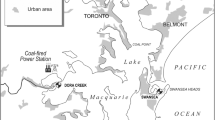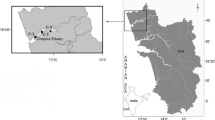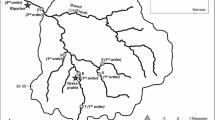Abstract
Trace elements used in animal feed additives can be introduced to aquatic environments through application of manures from animal feeding operations to agricultural land as fertilizer. The use of poultry feed additives containing arsenic (As) is of particular concern in the Shenandoah River watershed (Virginia, USA), an agricultural landscape with a high density of poultry operations. This study investigated the relationship between watershed characteristics of Shenandoah River tributaries and trace element concentrations in streambed sediment and tissue of resident mollusks, including: Asian clams (Corbicula fluminea), which are commonly used biomonitors, and pleurocerid snails (Leptoxis carinata), which are generally understudied. Results failed to support the primary hypothesis of a predictive relationship between watershed densities of poultry operations and As concentrations in sediment and mollusk tissue. However, there were statistical relationships between land use in tributary watersheds and other trace elements in sediment (Cu, Mn, Pb, Zn) and tissue (Cd, Hg, Pb). Principal components analysis of the sediment data suggested a possible geologic source of As at some sites. Tissue concentrations of As were significantly higher in snails than in clams, but clams accumulated higher concentrations of other trace elements (Cd, Cr, Hg, Pb, Se). Snails may be useful biomonitors of environmental As, but appear to be less suitable than clams for studies of landscape sources of other trace elements.




Similar content being viewed by others
References
Aldridge, D. W. (1982). Reproductive tactics in relation to life-cycle bioenergetics in three natural populations of the freshwater snail, Leptoxis carinata. Ecology, 63(1), 196–208.
Angelo, R. T., Cringan, M. S., Chamberlain, D. L., Stahl, A. J., Haslouer, S. G., & Goodrich, C. A. (2007). Residual effects of lead and zinc mining on freshwater mussels in the Spring River Basin (Kansas, Missouri, and Oaklahoma, USA). Science of the Total Environment, 384, 467–496.
Brock, E. H., Ketterings, Q. M., & McBride, M. (2006). Copper and zinc accumulation in poultry and dairy manure-amended fields. Soil Science, 171, 388–399.
Brown, K. M., Lang, B., & Perez, K. E. (2008). The conservation ecology of North American pleurocerid and hydrobiid gastropods. Journal of the North American Benthological Society, 27(2), 484–495.
Brown, B. L., Slaughter, A. D., & Schreiber, M. E. (2005). Controls on roxarsone transport in agricultural watersheds. Applied Geochemistry, 20, 123–133.
Buchman, M. F. (1999). NOAA screening quick reference tables. NOAA HAZMAT report 99–1, Seattle, WA, Coastal Protection and Restoration Division, National Oceanic and Atmospheric Administration.
Chernova, E. N. (2010). Changes in trace metal concentrations in the tissues of the White Sea mussel Mytilus edulis over the reproductive cycle. Russian Journal of Marine Biology, 36, 63–69.
Ciparis, S. (2011). Evaluation of the relationships between watershed-scale land use and contaminants in aquatic environments and the use of freshwater snails as indicators of impairment. Ph.D. Dissertation, Virginia Polytechnic Institute and State University.
Comelo, R. L., Paul, J. F., August, P. V., Copeland, J., Baker, C., Hale, S. S., et al. (1996). Relationships between watershed stressors and sediment contamination in Chesapeake Bay estuaries. Landscape Ecology, 11, 307–319.
Dicken, C. L., Nicholson, S. W., Horton, J. D., Kinney, S. A., Gunther, G., Foose, M. P., et al. (2005). Preliminary integrated geologic map databases for the United States: Delaware, Maryland, New York, Pennsylvania, and Virginia. United States Geological Survey. http://pubs.usgs.gov/of/2005/1325
Eriksson, L., Hermens, J. L. M., Johansson, E., Verhaar, H. J. M., & Wold, S. (1995). Multivariate-analysis of aquatic toxicity data with PLS. Aquatic Sciences, 57, 217–241.
Farag, A. M., Nimick, D. A., Kimball, B. A., Church, S. E., Harper, D. D., & Brumbaugh, W. G. (2007). Concentrations of metals in water, sediment, biofilm, benthic macroinvertebrates, and fish in the Boulder River watershed, Montana, and the role of colloids in metal uptake. Archives of Environmental Contamination and Toxicology, 52, 397–409.
Gagnon, C., & Saulnier, I. (2003). Distribution and fate of metals in the dispersion plume of a major municipal effluent. Environmental Pollution, 124, 47–55.
Gupta, G., & Gardner, W. (2005). Use of clay mineral (montmorillonite) for reducing poultry litter leachate toxicity (EC50). Journal of Hazardous Materials, B118, 81–83.
Harlavan, Y., Almogi-Labin, A., & Herut, B. (2010). Tracing natural and anthropogenic Pb in sediments along the Mediterranean coast of Israel using Pb isotopes. Environmental Science and Technology, 44, 6576–6582.
Homer, C., Dewitz, J., Fry, J., Coan, M., Hossain, N., Larson, C., et al. (2001). Completion of the 2001 National Land Cover Database for the conterminous United States. Photogrammetric Engineering and Remote Sensing, 73, 337–341.
Horowitz, A. J. (1991). Sediment-trace element chemistry. Chelsea, Michigan: Lewis.
Jackson, B. P., Bertsch, P. M., Cabrera, M. L., Camberato, J. C., Seaman, J. C., & Wood, C. W. (2003). Trace element speciation in poultry litter. Journal of Environmental Quality, 32, 535–540.
Kolka, R. K., Nater, E. A., Grigal, D. F., & Verry, E. S. (1999). Atmospheric inputs of mercury and organic carbon into a forested upland/bog watershed. Water, Air, and Soil Pollution, 113, 273–294.
Kolker, A., Engle, M. A., Orem, W. H., Bunnell, J. E., Lerch, H. E., Krabbenhoft, D. P., et al. (2008). Mercury, trace elements and organic constituents in atmospheric fine particulate matter, Shenandoah National Park, Virginia, USA: A combined approach to sampling and analysis. Geostandards and Geoanalytical Research, 32(3), 279–293.
Kuwabara, J. S., Chang, C. C. Y., & Pasilis, S. P. (1990). Effects of benthic flora on arsenic transport. Journal of Environmental Engineering, 116, 394–409.
Lee, B.-T., & Kim, K.-W. (2008). Arsenic accumulation and toxicity in the earthworm Eisenia fetida affected by chloride and phosphate. Environmental Toxicology and Chemistry, 27, 2488–2495.
Leff, L. G., Burch, J. L., & McArthur, J. V. (1990). Spatial distribution, seston removal, and potential competitive interactions of the bivalves Corbicula fluminea and Elliptio complanata, in a coastal plain stream. Freshwater Biology, 24, 409–416.
Leland, H. V., & Scudder, B. C. (1990). Trace elements in Corbicula fluminea from the San Joaquin River, California. Science of the Total Environment, 97(98), 641–672.
Levy, J. L., Stauber, J. L., Adams, M. S., Maher, W., Kirby, J. K., & Jolley, D. F. (2005). Toxicity, biotransformation, and mode of action of arsenic in two freshwater microalgae (Chlorella sp. and Monoraphidium arcuatum). Environmental Toxicology and Chemistry, 24, 2630–2639.
Luoma, S. N., Dagovitz, R., & Axtmann, E. (1990). Temporally intensive study of trace metals in sediments and bivalves from a large river-estuarine system: Suisun Bay/delta in San Francisco Bay. The Science of the Total Environment, 97(98), 685–712.
MacDonald, D. D., Ingersoll, C. G., & Berger, T. A. (2000). Development and evaluation of consensus-based sediment quality guidelines for freshwater ecosystems. Archives of Environmental Contamination and Toxicology, 39, 20–31.
Manning, B. A., & Goldberg, S. (1996). Modeling competitive adsorption of arsenate with phosphate and molybdate on oxide minerals. Soil Science Society of America Journal, 60, 121–131.
Mason, R. P., Laporte, J. M., & Andres, S. (2000). Factors controlling the bioaccumulation of mercury, methylmercury, arsenic, selenium, and cadmium by freshwater invertebrates and fish. Archives of Environmental Contamination and Toxicology, 38, 283–297.
McBride, M. (1994). Environmental chemistry of soils. New York: Oxford University Press.
McBride, M. B., & Spiers, G. (2001). Trace element content of selected fertilizers and dairy manures as determined by ICP-MS. Communications in Soil Science and Plant Analysis, 32, 139–156.
Mostafa, O. M. S. (2008). Effects of Fasicola gigantica experimental infection on some inorganic elements in the snail host Lymnaea natalensis. Experimental Parasitology, 118, 468–471.
Newman, M. C., Alberts, J. J., & Greenhut, V. A. (1985). Geochemical factors complicating the use of aufwuchs to monitor bioaccumulation of arsenic, cadmium, chromium, copper, and zinc. Water Research, 19, 1157–1165.
N'guessan, Y. M., Probst, J. L., Bur, T., & Probst, A. (2009). Trace elements in stream bed sediments from agricultural catchments (Gascogne region, S-W France): Where do they come from? Science of the Total Environment, 407, 2939–2952.
Ogendi, G. M., Brumbaugh, W. G., Hannigan, R. E., & Farris, J. L. (2007). Effects of acid-volatile sulfide on metal bioavailability and toxicity to midge (Chironomus tetans) larvae in black shale sediments. Environmental Toxicology and Chemistry, 26, 325–334.
Orndorff, Z. W. (2001). Evaluation of sulfidic materials in Virginia highway corridors. Ph.D. Dissertation, Virginia Polytechnic Institute and State University.
Pelletier, B. A., & Kenyon, D. (2000). Poultry litter for corn exchange program for Virginia. http://ideas.repec.org/s/ags/vturp.html.
Peltier, G. L., Meyer, J. L., Jagoe, C. H., & Hopkins, W. A. (2008). Using trace element concentrations of Corbicula fluminea to identify potential sources of contamination in an urban river. Environmental Pollution, 154, 283–290.
Peryea, F. J., & Kammereck, R. (1997). Phosphate-enhanced movement of arsenic out of lead arsenate-contaminated topsoil and through uncontaminated subsoil. Water, Air, and Soil Pollution, 93, 243–254.
Reimann, C., & de Caritat, P. (1998). Chemical elements in the environment: Factsheets for the geochemist and environmental scientist. Berlin: Springer.
Renshaw, C. E., Bostick, B. C., Feng, X., Wong, C. K., Winston, E. S., Karimi, R., et al. (2006). Impact of land disturbance on the fate of arsenical pesticides. Journal of Environmental Quality, 35, 61–67.
Ripley, J., Iwanowicz, L. R., Blazer, V. S., & Foran, C. (2008). Utilization of protein expression profiles as indicators of environmental impairment of smallmouth bass (Micropterus dolomieu) from the Shenandoah River, Virginia, USA. Environmental Toxicology and Chemistry, 27, 1756–1767.
Robinson, G. R., Larkins, P., Boughton, C. J., Reed, B. W., & Sibrill, P. L. (2007). Assessment of contamination from arsenical pesticide use on orchards in the Great Valley region, Virginia and West Virginia, USA. Journal of Environmental Quality, 36, 654–663.
Schooley, T., Weaver, M. J., Mullins, D., & Eick, M. (2008). The history of lead arsenate use in apple production: Comparison of its impact in Virginia with other states. Journal of Pesticide Safety Education, 10, 22–53.
Short, T. M., Deweese, L. R., & Dubrovsky, N. M. (2008). Discrimination of trait-based characteristics by trace element bioaccumulation in riverine fishes. Canadian Journal of Fisheries and Aquatic Sciences, 65, 1087–1100.
Shoults-Wilson, W. A., Peterson, J. T., Unrine, J. M., Rickard, J., & Black, M. C. (2009). The Asian clam Corbicula fluminea as a biomonitor of trace element contamination: Accounting for different sources of variation using a hierarchical linear model. Environmental Toxicology and Chemistry, 28, 2224–2232.
Simpson, R. D. (1979). Uptake and loss of zinc and lead by mussels (Mytilus edulis) and relationships with body weight and reproductive cycle. Marine Pollution Bulletin, 10, 74–78.
Simpson, S. L., & Batley, G. E. (2007). Predicting metal toxicity in sediments: A critique of current approaches. Integrated Environmental Assessment and Management, 3, 18–31.
Smedley, P. L., & Kinniburgh, D. G. (2002). A review of the source, behaviour and distribution of arsenic in natural waters. Applied Geochemistry, 17, 517–568.
Stollenwerk, K. (2003). Geochemical processes controlling transport of arsenic in groundwater: A review of adsorption. In K. Stollenwerk & A. Welch (Eds.), Arsenic in groundwater (pp. 67–100). Boston: Kluwer.
Tuncel, S. G., Olmez, I., Parrington, J. R., & Gordon, G. E. (1985). Composition of fine particle regional sulfate component in Shenandoah Valley. Environmental Science and Technology, 19, 529–537.
Tuttle, M. L. W., Breit, G. N., & Goldhaber, M. B. (2009). Weathering of the New Albany Shale, Kentucky: II. Redistribution of minor and trace elements. Applied Geochemistry, 24, 1565–1578.
United States Environmental Protection Agency & Virginia Department of Environmental Quality (2001). Development of Shenandoah River PCB TMDL. Final report. http://www.epa.gov/reg3.
Unrine, J. M., Hopkins, W. A., Romanek, C. S., & Jackson, B. P. (2007). Bioaccumulation of trace elements in omnivorous amphibian larvae: Implications for amphibian health and contaminant transport. Environmental Pollution, 149, 182–192.
Virginia Department of Environmental Quality (2005). Fish tissue analysis for metals 2005. http://www.deq.virginia.gov/fishtissue/fishtissue.html.
Virginia Department of Environmental Quality (2006). Final 2006 305(b)/303(d) water quality assessment integrated report. http://www.deq.state.va.us/wqa/ir2006.htm.
van der Perk, M. (2006). Soil and water contamination from molecular to catchment scale. Philadelphia: Taylor and Francis.
Yager, R. M., Southworth, S., & Voss, C. I. (2008). Simulation of ground-water flow in the Shenandoah Valley, Virginia and West Virginia, using variable-direction anisotropy in hydraulic conductivity to represent bedrock structure. United States Geological Survey Scientific Investigations Report 2008–5002.
Acknowledgments
We are grateful to G.W. Rice at the College of William and Mary for analysis of mollusk tissue and to R.C. Hale for coordination. The field and laboratory assistance of A. Braccia, S. Hiner, A. Eakins, S. Voshell, and T. Voshell was greatly appreciated. Insightful comments on early drafts of the manuscript were provided by W.H. Hopkins and thoughtful evaluation by an anonymous reviewer led to significant improvement. Funding for this project was provided, in part, by grants from the Virginia Environmental Endowment and the Virginia Department of Game and Inland Fisheries (supported by Federal Aid in Sport Fish Restoration).
Author information
Authors and Affiliations
Corresponding author
Rights and permissions
About this article
Cite this article
Ciparis, S., Schreiber, M.E. & Voshell, J.R. Using watershed characteristics, sediment, and tissue of resident mollusks to identify potential sources of trace elements to streams in a complex agricultural landscape. Environ Monit Assess 184, 3109–3126 (2012). https://doi.org/10.1007/s10661-011-2175-7
Received:
Accepted:
Published:
Issue Date:
DOI: https://doi.org/10.1007/s10661-011-2175-7




